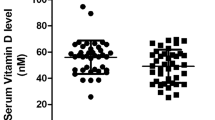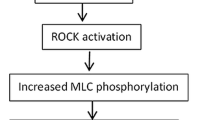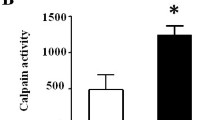Abstract
The dysfunction and further damage of endothelium play an important role in the development and progression of diabetic vascular complications. Protein tyrosine nitration is involved in endothelial cell injury induced by high glucose. Little is known about protein nitration in human umbilical vein endothelial cells (ECV304) induced by high glucose. In the present article, exposure of ECV304 to 30 mM high glucose (HG30) and 40 mM high glucose (HG40) or hemin–nitrite–H2O2 system for 72 h, the cell injury in ECV304 induced by high glucose and exogenous nitrating agent was studied. After 72 h treatment, it was found that high glucose stimulated ECV304 injury in a dose-dependent manner, including reducing cell viability, increasing malondialdehyde (MDA) content, decreasing glutathione (GSH) content, increasing intracellular reactive oxygen species (ROS), increasing the production of nitric oxygen (NO) (increased nitrite content in cell and nitrate content in medium) and generating protein tyrosine nitration. It was also found that protein tyrosine nitration could induce cell injury further. By comparison the protein tyrosine nitration induced by high glucose condition and extrinsic factors (hemin–nitrite–H2O2 system), it may be speculated that protein is nitrated selectively to generate nitrotyrosine in diabetic vascular complications.








Similar content being viewed by others
Abbreviations
- GSH:
-
Glutathione
- HG30:
-
30 mM high glucose
- HG40:
-
40 mM high glucose
- MDA:
-
Malondialdehyde
- NG:
-
Normal glucose
- NO:
-
Nitric oxygen
- NT:
-
Nitrotyrosine
- PGI2 :
-
Prostaglandin I2
- PI3:
-
Phosphatidyl inositol 3
- ROS:
-
Reactive oxygen species
- S.D:
-
Standard deviation
References
Rubani GM (1993) The role of endothelium in cardiovascular homeostasis and diseases. J Cardiovasc Pharmacol 22:S1–S14
Cohen RA (1993) Dysfunction of vascular endothelium in diabetes mellitus. Circulation 87:S67–S76
Laight DW, Carrier MJ, Anggard EE (1999) Endothelial cell dysfunction and the pathogenesis of diabetic macroangiopathy. Diabetes Metab Res Rev 15:274–282
Cosentino F, Lüscher TF (1998) Endothelial dysfunction in diabetes mellitus. J Cardiovasc Pharmacol 32:S54–61
Pănuş C, Moţa M, Vladu D, Vanghelie L, Răducanu CL (2003) The endothelial dysfunction in diabetes mellitus. Rom J Intern Med 41:27–33
Lash JM, Nase GP, Bohlen HG (1999) Acute hyperglycemia depresses arteriolar no formation in skeletal muscle. Am J Physiol 277:1513–1520
Kawano H, Motoyama T, Hirashima O, Hirai N, Miyao Y, Sakamoto T, Kugiyama K, Ogawa H, Yasue H (1999) Hyperglycemia rapidly suppresses flow-mediated endothelium-dependent vasodilation of brachial artery. J Am Coll Cardiol 34:146–154
Title LM, Cummings PM, Giddens K, Nassar BA (2000) Oral glucose loading acutely attenuates endothelium-dependent vasodilation in healthy adults without diabetes: an effect prevented by vitamins C and E. J Am Coll Cardiol 36:2185–2191
Shige H, Ishikawa T, Suzukawa M, Ito T, Nakajima K, Higashi K, Ayaori M, Tabata S, Ohsuzu F, Nakamura H (1999) Endothelium-dependent flow-mediated vasodilation in the postprandial state in type 2 diabetes mellitus. Am J Cardiol 84:1272–1274
Vehkavaara S, Seppälä-Lindroos A, Westerbacka J, Groop PH, Yki-Järvinen H (1999) In vivo endothelial dysfunction characterizes patients with impaired fasting glucose. Diabetes Care 22:2055–2060
Tesfamariam B, Cohen RA (1992) Free radicals mediate endothelial cell dysfunction caused by elevated glucose. Am J Physiol 263:H321–H326
Tesfamariam B (1994) Free radicals in diabetic endothelial cell dysfunction. Free Radic Biol Med 16:383–391
Giugliano D, Ceriello A, Paolisso G (1996) Oxidative stress and diabetic vascular complications. Diabetes Care 19:257–267
Ceriello A (2006) Oxidative stress and diabetes-associated complications. Endocr Pract 12:S60–S62
Nishikawa T, Araki E (2007) Impact of mitochondrial ROS production in the pathogenesis of diabetes mellitus and its complications. Antioxid Redox Signal 9:343–353
Brezniceanu ML, Liu F, Wei CC, Tran S, Sachetelli S, Zhang SL, Guo DF, Filep JG, Ingelfinger JR, Chan JS (2007) Catalase overexpression attenuates angiotensinogen expression and apoptosis in diabetic mice. Kidney Int 71:912–923
Chan NN, Vallance P, Colhoun HM (2000) Nitric oxide and vascular responses in Type I diabetes. Diabetologia 43:137–147
Farkas K, Sármán B, Jermendy G, Somogyi A (2000) Endothelial nitric oxide in diabetes mellitus: too much or not enough? Diabetes Nutr Metab 13:287–297
Endemann DH, Schiffrin EL (2004) Nitric oxide, oxidative excess, and vascular complications of diabetes mellitus. Curr Hypertens Rep 6:85–89
Cosentino F, Eto M, De Paolis P, van der Loo B, Bachschmid M, Ullrich V, Kouroedov A, Gatti CD, Joch H, Volpe M, Luscher TF (2003) High glucose causes upregulation of cyclooxygenase-2 and altes prostanoid profile in human endothelial cells. Circulation 107:1017–1023
Reddy S, Bradley J (2004) Immunohistochemical demonstration of nitrotyrosine, a biomarker of oxidative stress, in islet cells of the NOD mouse. Ann N Y Acad Sci 1037:199–202
Asghar M, Monjok E, Kouamou G, Ohia SE, Bagchi D, Lokhandwala MF (2007) Super CitriMax (HAC-SX) attenuates increases in oxidative stress, inflammation, insulin resistance, and body weight in developing obese Zucker rats. Mol Cell Biochem 304:93–99
Sarchielli P, Galli F, Floridi A, Floridi A, Gallai V (2003) Relevance of protein nitration in brain injury: a key pathophysiological mechanism in neurodegenerative, autoimmune, or inflammatory CNS diseases and stroke. Amino Acids 25:427–436
Reynolds MR, Berry RW, Binder LI (2007) Nitration in neurodegeneration: deciphering the “Hows” “nYs”. Biochemistry 46:7325–7336
Butterfield DA, Reed TT, Perluigi M, De Marco C, Coccia R, Keller JN, Markesbery WR, Sultana R (2007) Elevated levels of 3-nitrotyrosine in brain from subjects with amnestic mild cognitive impairment: implications for the role of nitration in the progression of Alzheimer’s disease. Brain Res 1148:243–248
Castegna A, Thongboonkerd V, Klein JB, Lynn B, Markesbery WR, Butterfield DA (2003) Proteomic identification of nitrated proteins in Alzheimer’s disease brain. J Neurochem 85: 1394–1401
Liu D, Bao F, Wen J, Liu J (2007) Mutation of superoxide dismutase elevates reactive species: comparison of nitration and oxidation of proteins in different brain regions of transgenic mice with amyotrophic lateral sclerosis. Neuroscience 146:255–264
Casoni F, Basso M, Massignan T, Gianazza E, Cheroni C, Salmona M, Bendotti C, Bonetto V (2005) Protein nitration in a mouse model of familial amyotrophic lateral sclerosis: possible multifunctional role in the pathogenesis. J Biol Chem 280:16295–16304
Zou MH, Shi C, Cohen RA (2002) High glucose via peroxynitrite causes tyrosine nitration and inactivation of prostacyclin synthase that is associated with thromboxane/prostaglandin H(2) receptor-mediated apoptosis and adhesion molecule expression in cultured human aortic endothelial cells. Diabetes 51:198–203
El-Remessy AB, Bartoli M, Platt DH, Fulton D, Caldwell RB (2005) Oxidative stress inactivates VEGF survival signaling in retinal endothelial cells via PI 3-kinase tyrosine nitration. J Cell Sci 118:243–252
van der Vliet A, Eiserich JP, Halliwell B, Cross CE (1997) Formation of reactive nitrogen species during peroxidase-catalyzed oxidation of nitrite. A potential additional mechanism of nitric oxide-dependent toxicity. J Biol Chem 272:7617–7625
Mosmann T (1983) Rapid colorimetric assay for cellular growth and survival: application to proliferation and cytotoxicity assays. J Immunol Methods 65:55–63
Rajeswari O, Natarajan R, Nadler JL, Kumar D, Kalra VK (1991) Glucose induces lipid peroxidation and inactivation of membrane-associated ion-transport enzymes in human erythrocytes in vivo and in vitro. J Cell Physiol 149:100–109
Hissin PJ, Hilf RA (1976) Fluorimetric method for determination of oxidized and reduced glutathione in tissues. Anal Biochem 74:214–226
Jiao HL, Ye P, Zhao BL (2003) Protective effects of green tea polyphenols on human HepG2 cells against oxidative damage of fenofibrate. Free Radic Biol Med 35:1121–1128
Ye J, Wang S, Leonard SS, Sun Y, Butterworth L, Antonini J, Ding M, Rojanasakul Y, Vallyathan V, Castranova V, Shi X (1999) Role of reactive oxygen species and p53 in chromium(VI)-induced apoptosis. J Biol Chem 274:34974–34980
Zou MH, Ullrich V, Cohen R (2004) Peroxynitrite and vascular endothelial dysfunction in diabetes mellitus. Endothelium 11:89–97
Ruderman NB, Williamson JR, Brownlee M (1992) Glucose and diabetic vascular disease. FASEB J 6:2905–2914
Cohen RA (2005) Role of nitric oxide in diabetic complications. Am J Ther 12:499–502
Duffy A, Liew A, O’Sullivan J, Avalos G, Samali A, O’Brien T (2006) Distinct effects of high-glucose conditions on endothelial cells of macrovascular and microvascular origins. Endothelium 13:9–16
Camici GG, Schiavoni M, Francia P, Bachschmid M, Martin-Padura I, Hersberger M, Tanner FC, Pelicci P, Volpe M, Anversa P, Lüscher TF, Cosentino F (2007) Genetic deletion of p66(Shc) adaptor protein prevents hyperglycemia-induced endothelial dysfunction and oxidative stress. Proc Natl Acad Sci USA 104:5217–5222
Nishikawa T, Edelstein D, Du XL, Yamagishi S, Matsumura T, Kaneda Y, Yorek MA, Beebe D, Oates PJ, Hammes HP, Giardino I, Brownlee M (2000) Normalising mitochondrial superoxide production blocks three pathways of hyperglycemic damage. Nature 404:787–790
Tachi Y, Okuda Y, Bannai C, Okamura N, Bannai S, Yamashita K (1998) High concentration of glucose causes impairment of the function of the glutathione redox cycle in human vascular smooth muscle cells. FEBS Let 421:19–22
Myatt L, Cui X (2004) Oxidative stress in the placenta. Histochem Cell Biol 122:369–382
Zhao YL, Li HL, Gao ZH, Gong YF, Xu HB (2006) Effects of flavonoids extraced from Scutellaria baicalensis Georgi on Hemin–nitrite–H2O2 induces liver injury. Eur J Pharmacol 536:192–199
Acknowledgments
This work was supported by grants from the National Natural Science Foundation of China (No. 30300073), the Program for New Century Excellent Talents in University (No. NCET-05-0649) and E-Institutes of Shanghai Municipal Education Commission (No.E-04010).
Author information
Authors and Affiliations
Corresponding author
Rights and permissions
About this article
Cite this article
Zhao, Y., Lu, N., Li, H. et al. High glucose induced human umbilical vein endothelial cell injury: involvement of protein tyrosine nitration. Mol Cell Biochem 311, 19–29 (2008). https://doi.org/10.1007/s11010-007-9688-y
Received:
Accepted:
Published:
Issue Date:
DOI: https://doi.org/10.1007/s11010-007-9688-y




